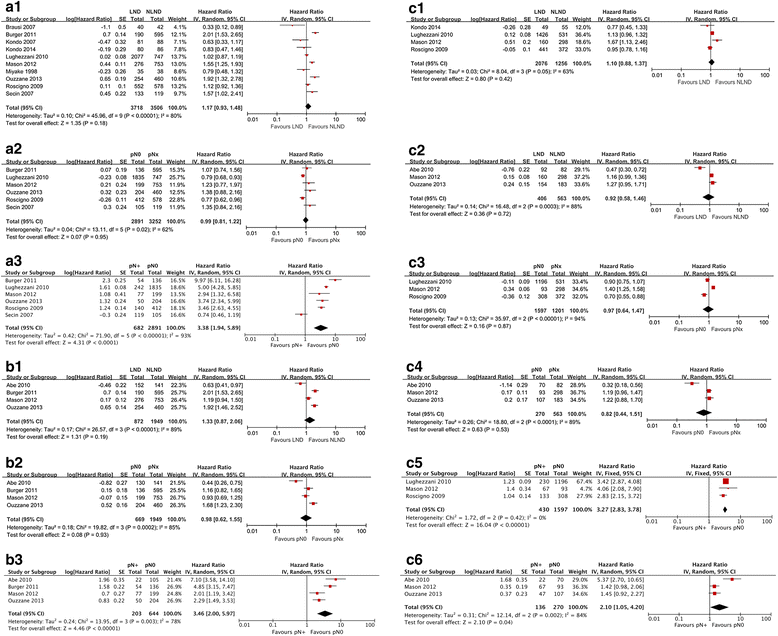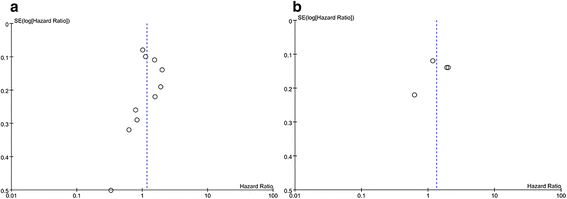Role of lymph node dissection in the management of upper tract urothelial carcinomas: a meta-analysis
- PMID: 29636103
- PMCID: PMC5894184
- DOI: 10.1186/s12894-018-0336-5
Role of lymph node dissection in the management of upper tract urothelial carcinomas: a meta-analysis
Abstract
Background: Lymph node dissection (LND) is not routinely performed during radical nephroureterectomy (RNU) in upper tract urothelial carcinomas (UTUC) and the role of LND has been controversial. We aim to investigate whether patients with LND had improved survival in UTUC patients.
Methods: We performed a systematic literature search of PubMed, Embase, and Cochrane library for citations published prior to January 2016, describing LND performed among UTUC patients and conducted a standard meta-analysis of survival outcomes.
Results: Eleven eligible studies containing 7516 patients satisfied the inclusion criteria. Pooled HRs for cancer-specific survival (CSS) and recurrence-free survival (RFS) were 1.17 (P = 0.18) and 1.33 (P = 0.19) respectively. However, the patients in the LND group had more advanced tumour stages and grades (P < 0.001). Further subgroup analysis showed that among muscle-invasive UTUC patients, the pooled HR for CSS and RFS were 1.10 (P = 0.42) and 0.92 (P = 0.72) respectively. Besides, no difference was found in CSS and RFS between pN0 and pNx individuals in overall populations and in patients with muscle-invasive UTUC, while pN+ patients had significantly worse prognosis when compared to pN0 patients.
Conclusions: LND during RNU allows more accurate staging and prediction of survival, but it remains uncertain whether LND independently improves survival in patients with UTUC. However, standard use of LND should be further investigated in a multi-center, prospective evaluation to obtain a definitive statement regarding this matter.
Keywords: Lymph node dissection; Recurrence; Survival; Upper urinary tract; Urothelial carcinoma.
Conflict of interest statement
Competing interest
The authors declare that they have no competing interests.
Consent for publication
Not applicable.
Publisher’s Note
Springer Nature remains neutral with regard to jurisdictional claims in published maps and institutional affiliations.
Figures



Similar articles
-
Lymph node dissection could bring survival benefits to patients diagnosed with clinically node-negative upper urinary tract urothelial cancer: a population-based, propensity score-matched study.Int J Clin Oncol. 2019 Mar;24(3):296-305. doi: 10.1007/s10147-018-1356-6. Epub 2018 Oct 17. Int J Clin Oncol. 2019. PMID: 30334174
-
Effect of Lymphadenectomy During Radical Nephroureterectomy in Locally Advanced Upper Tract Urothelial Carcinoma.Clin Genitourin Cancer. 2017 Oct;15(5):556-562. doi: 10.1016/j.clgc.2017.04.004. Epub 2017 Apr 10. Clin Genitourin Cancer. 2017. PMID: 28501481
-
Effect of lymph node dissection on the outcomes of upper tract urothelial carcinomas: a meta-analysis.Expert Rev Anticancer Ther. 2014 Jun;14(6):667-75. doi: 10.1586/14737140.2014.895670. Epub 2014 Mar 27. Expert Rev Anticancer Ther. 2014. PMID: 24673605
-
Contemporary role of lymph node dissection at the time of radical nephroureterectomy for upper tract urothelial carcinoma.World J Urol. 2017 Apr;35(4):535-548. doi: 10.1007/s00345-016-1764-z. Epub 2016 Jan 25. World J Urol. 2017. PMID: 26809456 Review.
-
Potential Benefit of Lymph Node Dissection During Radical Nephroureterectomy for Upper Tract Urothelial Carcinoma: A Systematic Review by the European Association of Urology Guidelines Panel on Non-muscle-invasive Bladder Cancer.Eur Urol Focus. 2019 Mar;5(2):224-241. doi: 10.1016/j.euf.2017.09.015. Epub 2017 Nov 20. Eur Urol Focus. 2019. PMID: 29158169
Cited by
-
Clinical Efficacy of Adjuvant Chemotherapy in Advanced Upper Tract Urothelial Carcinoma (pT3-T4): Real-World Data from the Taiwan Upper Tract Urothelial Carcinoma Collaboration Group.J Pers Med. 2022 Feb 6;12(2):226. doi: 10.3390/jpm12020226. J Pers Med. 2022. PMID: 35207714 Free PMC article.
-
Diagnosis and Management of Upper Tract Urothelial Carcinoma: A Review.Cancers (Basel). 2025 Jul 25;17(15):2467. doi: 10.3390/cancers17152467. Cancers (Basel). 2025. PMID: 40805166 Free PMC article. Review.
-
The effectiveness of chemotherapy for patients with pT3N0M0 renal pelvic urothelial carcinomas: An inverse probability of treatment weighting comparison using Surveillance, Epidemiology, and End Results data.Cancer Med. 2020 Aug;9(16):5756-5766. doi: 10.1002/cam4.3238. Epub 2020 Jun 25. Cancer Med. 2020. PMID: 32585775 Free PMC article.
-
Metastatic clear cell renal cell carcinoma in isolated retroperitoneal lymph node without evidence of primary tumor in kidneys: A case report.World J Clin Oncol. 2020 Feb 24;11(2):103-109. doi: 10.5306/wjco.v11.i2.103. World J Clin Oncol. 2020. PMID: 32133279 Free PMC article.
-
Kidney-Sparing Surgery for Upper Tract Urothelial Carcinoma-Modalities, Outcomes, and Limitations.J Clin Med. 2024 Nov 2;13(21):6593. doi: 10.3390/jcm13216593. J Clin Med. 2024. PMID: 39518735 Free PMC article. Review.
References
-
- Oxford Centre for Evidence-based Medicine Levels of Evidence (May 2009). Produced by bob Phillips, Chris ball, Dave Sackett, Doug Badenoch, Sharon Straus, Brian Haynes, Martin Dawes since November 1998. Updated by Jeremy Howick March 2009.
-
- Schatteman P, Chatzopoulos C, Assenmacher C, De Visscher L, Jorion JL, Blaze V, et al. Laparoscopic nephroureterectomy for upper urinary tract transitional cell carcinoma: results of a Belgian retrospective multicentre survey. Eur Urol. 2007;51:1633–1638. doi: 10.1016/j.eururo.2006.09.016. - DOI - PubMed
Publication types
MeSH terms
Grants and funding
LinkOut - more resources
Full Text Sources
Other Literature Sources

